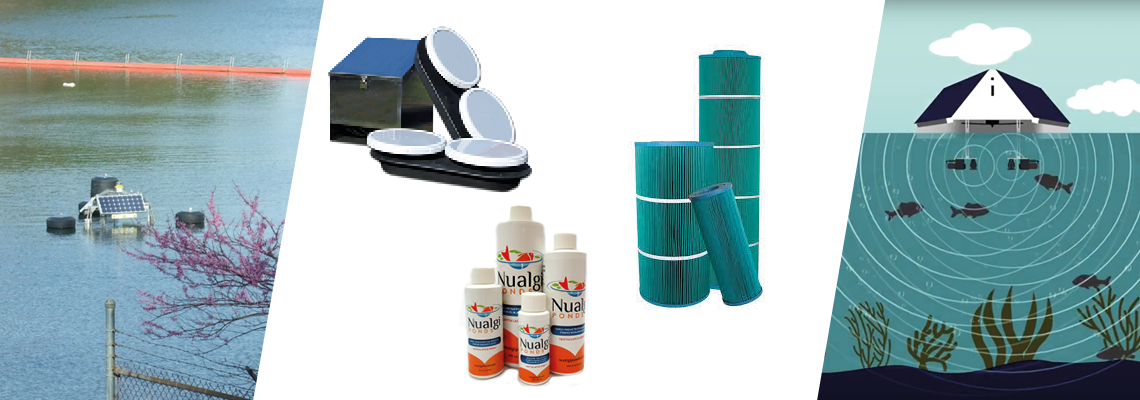Prevention and treatment: 5 companies to watch in the fight against algae
Enemy number one
Algae blooms have quickly become public enemy number one.
In 2020, the Harmful Algae Event Database recorded 471 incidents of toxic/harmful algae blooms worldwide, and already this year 101 events have been reported in the space of three months.
Algal blooms can become a significant threat to our surface water sources and inland ecosystems.
According to the United States Environmental Protection Agency, "harmful algae blooms (HABs) produce extremely dangerous toxins that can sicken or kill people and animals, create dead zones in the water, raise treatment costs for drinking water, and hurt industries that depend on clean water."
One of the most recent high profile incidents was in Singapore when a canal turned a vivid pink due to a bloom.
Speaking to Aquatech Online on the rise of algae blooms, Maarten van Schijndel, water systems advisor at Waterschap De Dommel, said: “Agriculture is getting more intense, more traffic and aeroplanes, they all have an influence on surface water and algal blooms.”
Innovations taking the fight against algae
Algae and algal blooms are formed as a result of several factors including; available nutrients, temperature, light, ecosystem, disturbance, hydrology and the chemistry of the water.
The most common type of algae, cyanobacteria, requires carbon dioxide and sunlight to grow as well as nutrients in the form of nitrogen and phosphorous.
Following the Toledo water crisis, the Ohio Environmental Protection Agency (Ohio EPA) approved a $4.4 million plan in 2014 for short-term HAB treatment upgrades to the City's water treatment plant, according to an article from Frontiers.
In 2018 they invested $44.5 million into a plan for long-term HAB treatment upgrades. These upgrades were part of a larger 10-year, $500 million investment plan to upgrade the Toledo water treatment system.
With incidents on the rise, the algae treatment and prevention market is seeing a steady rise. In recent years, however, new designs and methods of treating and preventing algae have been developed and trickled into the market.
Aquatech looks at five companies to watch in the algae prevention and treatment market:
SolarBee: IXOM Watercare

Image source: Ixom Watercare
This first company causing a buzz (sorry...) is IXOM Watercare, a US water and wastewater treatment company that produces the SolarBee SB mixers to tackle cyanobacteria through mixing and circulation of water.
The SolarBee works by utilising the way water forms in small horizontal layers in reservoirs. A powerful mixing drive is powered by solar energy from the panels attached on the top of the device, drawing water in at a specific depth from all corners of the water basin.
Self-sustainable, able to power itself 24/7 through solar, the SolarBee also features a digital logic for efficient power management, an auto-reserve and an anti-jam setting.
On top of this, the SolarBee is scalable, meaning it is suitable for installation in lakes and water reservoirs, potable water systems, stormwater and even wastewater treatment systems.
“What makes the SolarBee unique is that it is self-sustainable, able to power itself 24/7 on solar power alone.”
Installed just above the thermocline, the SolarBee starts to pull water from longer distances at the specified depth.
"The water enters the intake at one foot per second and once it reaches the surface distribution dish, it starts to direct long-distance near laminar radial flow away from the SolarBee," said IXOM Watercare.
"This is known as direct flow, and once this is established, the induced flow patterns begin to take shape."
Harmsco Filtration Products: A multi-barrier approach

Image source: Storm Water Solutions
Founded in 1958, Harmsco Filtration Products offers a multi-barrier approach to physically remove algae blooms/cyanobacteria before they burst in the treatment process. Algae are then removed extracellularly through adsorption.
“The filter has various application in drinking water treatment, irrigation, livestock drinking water treatment, and in small lakes and ponds.”
The Harmsco Filtration Products filter offers a two-stage filtration process: a pre-filter removes the intact algae and inhibits algae growth on the filter cartridge through a combination of filtration media and silver zeolite in the media.
A second filter with activated carbon adsorbs any remaining metabolites (taste, odours or cyanotoxins). The filter has various applications in drinking water treatment, irrigation, livestock drinking water treatment, and in small lakes and ponds.
Speaking on Harmsco Filtration Products filter media, Storm Water Solutions said the "anti-microbial media and the activated carbon make for easy cleaning for extended use and remove extra-cellular cyanotoxins”.
LG Sonic: MPC Buoy & Water Monitoring Buoy

Image source: LG Sonic
It was in June last year that Dutch water technology company, LG Sonic, added a new addition to its portfolio to help detect algae blooms in water lakes and reservoirs.
Called the Monitoring Buoy, the solution combines real-time water quality monitoring and cloud software to store and analyse water quality data.
What makes the MPC Buoy stand out in the market is its innovative technology that destroys algae by creating a sound barrier in the upper layer of the water.
Lisa Brand, chief technology officer (CTO) of LG Sonic told Aquatech Online: "LG Sonic has developed an ultrasonic technology that controls the growth of algae without negatively impacting the rest of the ecosystem."
“It is the only technology in the world that can be used on large water surfaces in an environmentally friendly manner.”

Image source: The Water Network
The MPC Buoy is designed to be used in tandem with the Monitoring Buoy, which continuously monitors water quality in real-time and delivers the data via radio, GPRS, or 3G to web-based software.
"It makes use of real-time water quality monitoring and advanced prediction models to analyse the type and growth stage of algae and optimises its treatment based on this," Brand added.
"Because of that, the treatment only impacts algal growth, allowing an aquatic ecosystem to re-establish after algal blooms.
"It is the only technology in the world that can be used on large water surfaces in an environmentally friendly manner."
Otterbine Barebo: Air Flo 3

Image source: Otterbine
The Air Flo 3 is a subsurface aerator that disrupts algae growth through aeration by de-stratifying and circulating water without disturbing the natural surroundings.
Otherwise called the 'underwater bubbler', it can be installed in most ponds and lakes, operating optimally at depths of 8ft (2.4 meters), with a maximum depth of 40ft (12 meters).
A cabinet is installed on a bank, and manifolds run from it that are connected to the Air Flo system placed under the water.
“The system allows room for future expansion, with valve manifolds located in the cabinet.”
Otterbine said the Air Flo 3 increase oxygen transfer by 20 per cent and is built to withstand the heat featuring a dual cabinet cooling system.
The system comes with either a singular or dual self-cleaning disc diffuser and is made from stainless steel to avoid corrosion. The Air Flo 3 can be installed and operate below the surface, keeping it hidden away and not obstructing scenery.
Plus, the system allows room for future expansion, with valve manifolds located in the cabinet.
The systems require little maintenance other than the occasional check-up, but the air filters need to be changed annually.
Nuali Ponds: Natural algaecide

Image source: Nualgi Ponds
One area where the market has become saturated in recent years is the pool-owners go-to algae deterrent, algaecides.
Algaecides work as oxidisers that destroy the cell walls of algae on contact with the substance. These oxidising chemicals work quickly and are capable of destroying almost all algae particles within a short period of time.
The catch with Algaecides is that they do still require some manual labour to remove the destroyed algae; otherwise, they will remain in the water and could clog up filters or settle on the ground.
If you do not manually remove the algae, it will decompose and dissolve the oxygen levels in the water.
Nualgi Ponds: Algae Control is a natural algaecide that promotes the growth of silica-body algae called diatoms, which actively starve and compete with harmful algae in the water.
One benefit of algaecide is the cheaper price point, as well its simple application.
Related content
- Democratising data: 5 start-ups to watch in water quality monitoring
- Understanding algae blooms
- Predicting the algae bloom: LG Sonic bolsters tech portfolio
Share your water technology stories with us
Do you have an innovation, research results or an other interesting topic you would like to share with the international water technology industry? The Aquatech website and social media channels are a great platform to showcase your stories!
Please contact our Sr Brand Marketing Manager Annelie Koomen.
Are you an Aquatech exhibitor?
Make sure you add your latest press releases to your Company Profile in the Exhibitor Portal for free exposure.
We promise never to send you spam and you can unsubscribe at any time!


.jpg?h=628&iar=0&w=1200)
.jpg?h=628&iar=0&w=1200)